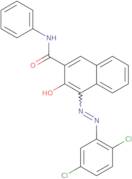Pigment Red 2 - Technical
CAS: 6041-94-7
Ref. 3D-FP33459
| 1g | Descontinuado | ||
| 2g | Descontinuado | ||
| 5g | Descontinuado | ||
| 250mg | Descontinuado | ||
| 500mg | Descontinuado |
Informação sobre produto
- (4E)-4-[(2,5-dichlorophenyl)hydrazono]-3-oxo-N-phenyl-3,4-dihydronaphthalene-2-carboxamide
- 1-(2,5-Dichlorophenylazo)-3-phenylcarbamoyl-2-naphthol
- 12310
- 2-Naphthalenecarboxamide, 4-[(2,5-dichlorophenyl)azo]-3-hydroxy-N-phenyl-
- 2-Naphthalenecarboxamide, 4-[2-(2,5-dichlorophenyl)diazenyl]-3-hydroxy-N-phenyl-
- 2-Naphthanilide, 4-(2,5-dichlorophenylazo)-3-hydroxy-
- 4-[(E)-(2,5-dichlorophenyl)diazenyl]-3-hydroxy-N-phenylnaphthalene-2-carboxamide
- 4-[2-(2,5-Dichlorophenyl)diazenyl]-3-hydroxy-N-phenyl-2-naphthalenecarboxamide
- Confast Red 2R
- Fast Red F 2R
- Ver mais sinónimos
- Flash Red R 100
- Irgalite Red FBN
- Irgalite Red FBS
- Irgalite Red FBX
- Isol Aryl Red 2R
- Kromon Red 2R
- Lutetia Fast Red BR
- Lutetia Fast Red F 2R
- Monolite Fast Paper Red 2R
- Monolite Fast Red 2R
- Monolite Fast Red 2RA
- Monolite Fast Red 2RV
- Naftol Red RN 1533
- Naphthol Red 2R
- Naphthol Red Light 10397
- Permanent Red F 2R
- Permanent Red FRR
- Pigment Red 2R
- Pigment Scarlet 2S
- Pigment Scarlet 2STP
- Pigment Scarlet 2SV
- Recolite Fast Red 2R
- Revere Red X 2198
- Scarlet 2S
- Sico Fast Red P 16R
- Sico Fast Red P 2RH
- Silopol Red R
- Silosol Red RHN
- Siloton Red F 2R
- Syton Fast Red F 2R
- Tertropigment Red PF 2R
- Unisperse Red FBN-PI
- Versal Fast Red F 2R
- C.I. Pigment Red 2
Pigment Red 2 is a red pigment with a deep, intense shade. It is used in paints and dyes, but also as a food additive. Pigment Red 2 consists of a glycol ether that has been modified by the addition of nitrogen atoms and an intramolecular hydrogen bond. The molecule is stabilized by intermolecular hydrogen bonding with chitosan quaternary ammonium ions. The pigment's chemical stability is increased by anhydrous sodium or hydroxyl groups.
The molecule reacts to form diazonium salt with an oxidizing agent in solution. This reaction can be initiated by light exposure, which results in the production of particle and the formation of an inorganic acid (e.g., sulfuric acid). The structural analysis of this molecule shows that it contains two hydroxyl groups on opposite sides of the aromatic ring, which may explain its photochemical properties.





